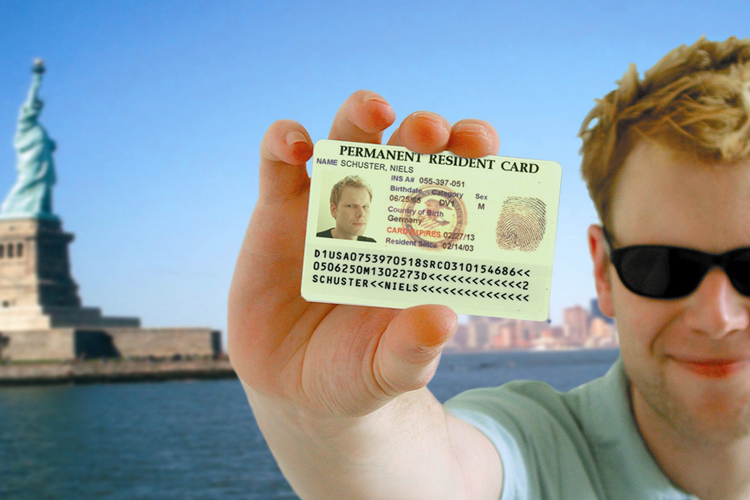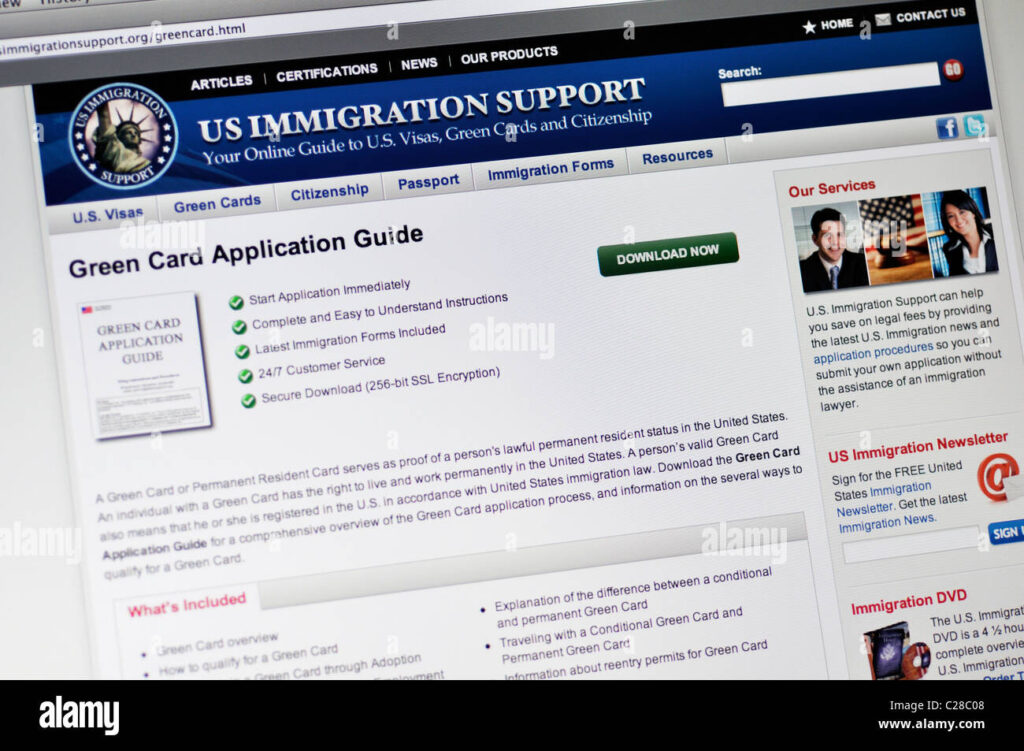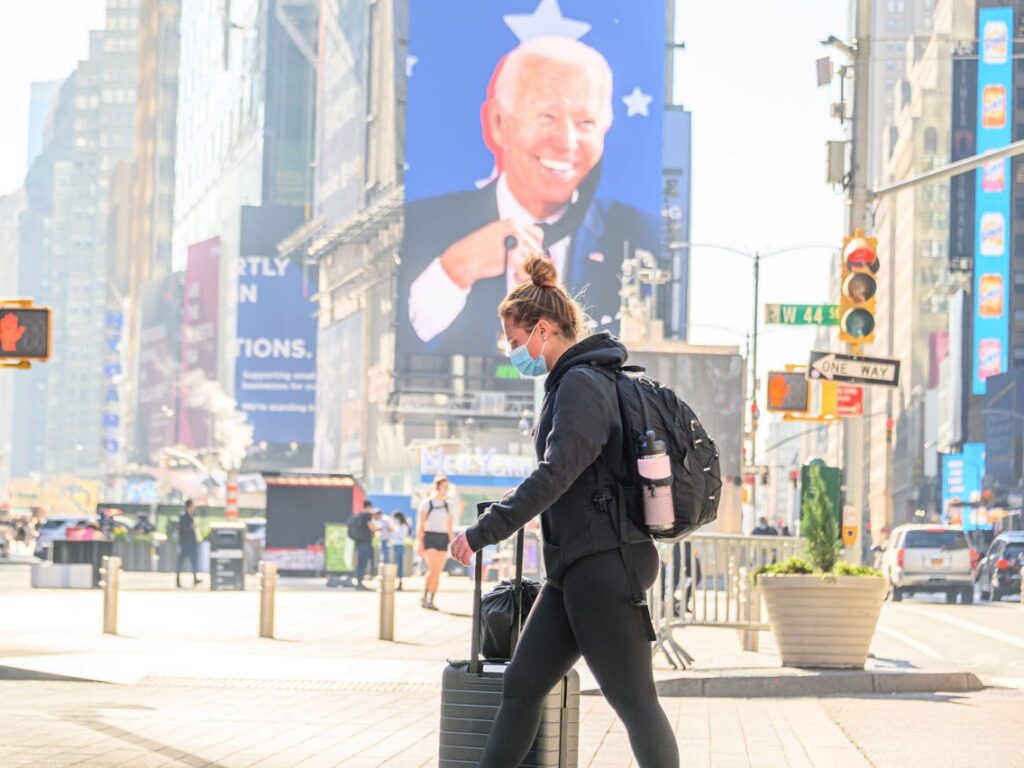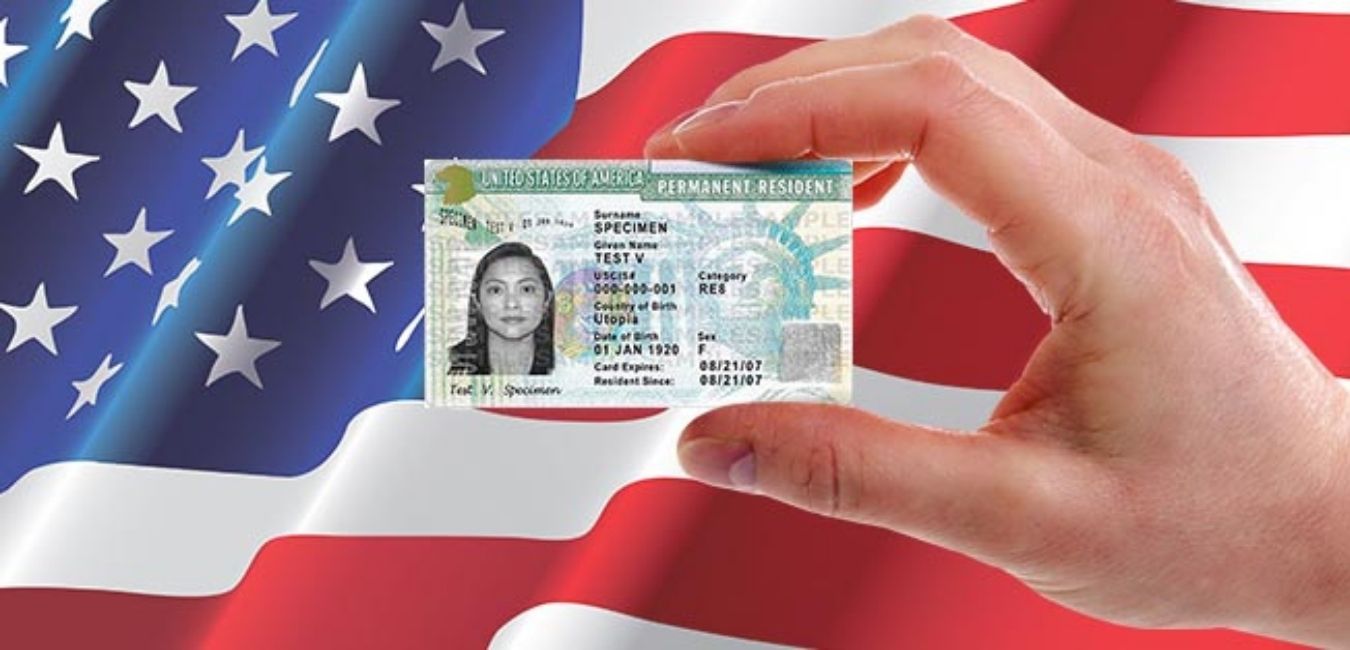US Green Card – What is the most common way to get a green card? Here is a guide in 12 steps to becoming a permanent American resident.

A foreign citizen seeking to live permanently in the United States requires an immigrant visa. This is sometimes called getting a green card.
If you’re an immigrant, a green card is key to becoming a United States citizen. The formal term for a green card is a Permanent Residence Card. Having a green card allows you to legally live and work in the United States.
Permanent Residents (often called green card holders) are authorized to live and work on a permanent basis in the U.S. Whereas most nonimmigrants must document their intent to depart the U.S. after a period in the U.S., green card holders should have the intent to remain in the U.S.
When people talk about the easiest way to get a “green card” (U.S. lawful permanent residence) they are usually interested in a combination of:
- Which way of getting a green card is fastest?
- Which way of getting a green card has the least demanding eligibility requirements?
There is no single answer to these questions. And of course, immigration eligibility depends in part on one’s personal circumstances.
There are several ways to obtain permanent residency in the U.S, including:
- A petition from an employer
- The employment-based green card application system allows for five preference categories, commonly abbreviated as EB-1, EB-2, etc. Each preference category may have several sub-categories.
- Marriage to a U.S. citizen
- Sponsorship by a close relative who is a U.S. citizen or legal permanent resident
- The U.S. Department of State diversity lottery program.
While each application process ultimately leads to the same goal, the green card, the application procedures, and associated costs vary. The timeline for completing a green card application heavily depends on the type of application as well as the country of birth of the applicant. Applications under the first employment-based preference category might be completed in as little as 6-8 months, whereas the other processes for individuals will take years. Please consult with FSIS to discuss the timeline of a given green card application.
TheVibely through this article will address the green card categories people most commonly use to enter the U.S., among them:
What is the most common way to get a green card?
2. Green Card Through a Job.
3. Green Card Lottery Through Diversity Visa Immigration.
4. Being a Refugee or an Asylee.
5. Study Your Way In.
6. Investors.
7. Special Immigrants.
8. Adjustment of Status.
9. Consular Processing – Immigrant Visa.
10. Replace or Renew Green Card.
11. I-130 and I-140 Petition.
12. Labor certification.

1. Green Card Through Family And Marriage
This is an opportunity majority take to become permanent residents in the United States. Green card opportunities in families are mostly based on sponsored Visa categories
If you’re a close relative to a U.S. citizen or a green card holder, they can petition for you to obtain legal permanent residency. This option is the fastest and most popular path to getting a green card. U.S. citizens are permitted to petition for immediate relatives who are immediately eligible for immigrant visas, with no annual limits or resulting wait (they are not even listed in the Visa Bulletin), including:
- Spouses
- Unmarried children under 21 years of age
- Parents of U.S. citizens who are over 21 years old
In addition to immediate relatives of U.S. citizens above, there are the following preference categories for relatives of U.S. citizens and green card holders:
- First Preference: Unmarried, adult sons and daughters over age 21 of U.S. citizens.
- Second Preference (2A): Spouses of green card holders, unmarried children under 21 of permanent residents
- Second Preference (2B): Unmarried sons and daughters over 21 of permanent residents
- Third Preference: Married sons and daughters (any age) of U.S. citizens
- Fourth Preference: Brothers and sisters of adult U.S. citizens
Notice that none of these are extended family (i.e. no cousins or grandparents).
Among these so-called “preference relatives” (not immediate relatives), the shortest waits are often enjoyed by spouses and unmarried, under-21 children of U.S. permanent residents, typically between two months and two years. But it all depends on demand, or how many people apply before you.
Your relative must legally establish the relationship using USCIS Form I-130 Petition for an Alien Relative. That application is followed by Form I-485, Adjustment of Status (if you are in the U.S.). In some instances, both applications can be completed together. If your relative is a green card holder, this process is the same as for U.S. citizens, but it will likely take longer.
Relatives who are not in the United States will have to go through consular processing. This means their green cards are issued by the U.S. Department of State. Once the Department of State grants them a visa, they will get a green card when they’re admitted into the United States.
U.S. citizens can also petition for siblings and married children over 21. However, that process generally takes a lot longer because these individuals are not considered immediate relatives.
If you get married or turn 21 years old, things change, and immigration law states you will have to wait longer in order to get a green card through a U.S. citizen relative.
There are also a few particular circumstances where you can get a green card using USCIS Form I-360: Petition for Amerasian, Widow(er) of a U.S. citizen, or Special Immigrant. These include being a:
- Battered spouse or child
- Widow or widower of a U.S. citizen
- A special immigrant including religious worker, U.S. Armed Forces member, and more categories.

2. Green Card Through a Job
In the employment-based preference categories, unlike family-based preferences, an employer in the U.S. is usually the entity sponsoring a foreign national. In addition, the employment-based categories are mostly delineated by the difficulty and educational requirements of the employment that the foreign national is to undertake. Two prominent exceptions are the Fourth and Fifth employment-based preference categories. More on these later.
Though the wait times for employment-based immigrant visas are relatively short in most categories, the application process requires a huge amount of work and documentation from both you and the sponsoring employer. And, the basic eligibility requirements can be quite demanding in terms of applicants’ job skills, education, and experience.
Here are the actual categories:
- Employment First Preference (EB-1): “Priority workers,” who are considered outstanding in their field, such as internationally recognized artists, award-winning scientists, or the like, or executives or CEOs of multinational companies.
- Employment Second Preference (EB-2): Professionals who hold advanced degrees or persons of exceptional ability.
- Employment Third Preference (EB-3): Persons whose proposed employment in the U.S. will require at least a Bachelor’s degree-level education in some specialized field, and some unskilled workers (but the wait is very long). The Second and Third Preferences require in most cases that an employer sponsoring the foreign national conduct a “market test” of the job market, to ensure that no U.S. citizens or permanent residents already in the U.S. will be displaced from an available job.
- Employment Fourth Preference (EB-4): So-called “special” immigrants, including certain kinds of religious workers as well as certain juveniles needing to join foster families in the United States. The requirements for this category are highly technical and beyond the scope of this article.
- Employment Fifth Preference: Known colloquially as the “Job Creation Visa,” this is for foreign nationals who can invest a large sum of personal assets into a venture in the U.S. that can employ at least ten U.S. citizens or permanent residents on a full-time basis. Aside from the high monetary requirements, U.S. immigration authorities carefully scrutinize to petitions under this category because of a perceived likelihood of fraud.
Overall, if you have an employer willing to sponsor you under the First, Second, or Third Preference categories, or if you have the financial resources to invest under the Fifth Preference program, you will have a shorter wait time to attain permanent residence. However, the underlying requirements and procedures for employment-based immigration are nothing to sneeze at. Speak with your potential employer, as well as a licensed immigration attorney.

3. Green Card Lottery Through Diversity Visa Immigration
You might have heard the Diversity Immigrant Visa (DV) program referred to as a “lottery” for green cards. This is not far off the mark.
U.S. immigration law makes available 55,000 immigrant visa numbers for foreign nationals from countries that have low numbers of permanent residence applications to the United States. If you meet the minimum educational requirements, can prove that you’ll be able to support yourself financially in the United States, and do not have issues in terms of past criminal activity, immigration violations, or other problems, you can apply under the DV program for a chance to be randomly selected and assigned an immigrant visa number right away.
Unfortunately, as with all lotteries, your chances of success through the DV program depend upon both personal circumstances and luck. Further, if you come from a country with already-high numbers of permanent resident applicants, your chances of being selected for a DV immigrant visa lessen dramatically.
However, if you are selected under the DV program, you will have an immediately available immigrant visa number and a short path to a green card, provided you can get through the processing before the visas run out for that year (a challenge in and of itself).
4. Being a Refugee or an Asylee
Immigrants who arrive in the United States as a refugee or an asylee can apply for a green card one year after entering the country. This also applies to immediate family members of asylees. Here’s what refugees and asylum seekers need to know:
- Refugees must submit an application for a green card after being in the country for a year.
- Asylees are not required to apply for green cards.
- Refugees or Asylees typically do not need to file an immigrant petition such as an I-130 or I-140 with the USCIS if they meet the requirements to apply for a green card. They can file for I-485 adjustment of status directly.

5. Study Your Way In
Get a student visa to study at a U.S. college to get a bachelor’s or master’s degree. That will entitle you to a one-year post-graduate work permit called Optional Practical Training. Following the one year, get your boss to apply for an H1B work visa for you. Then, get the boss to apply for labor certification from the Department of Labor evidencing that there are no American workers who are ready, willing, and able to take the job.
Then apply for a green card through the Department of Homeland Security U.S. Citizenship and Immigration Service. This is a long and winding road, full of agony, but it may be the only option for many applicants, especially those who have skills but little money to invest and no family in the USA.
6. Investors
The EB-5 direct investor program currently enables investor immigrants to get green cards by investing as little as $ 500,000 in their businesses, provided they create ten new jobs. Foreign entrepreneurs who invest $1,000,000 in a commercial enterprise that will benefit the U.S. economy and create at least 10 full-time U.S. jobs.
This opportunity is temporary and is likely to close by the end of the year with the amount required likely to go up to $ 900,000 as it was before. A regional center variation of this program is currently closed and awaiting reopening by Congress.
7. Special Immigrants
1. EB4 Green Card Religious Workers Eligibility – It Is Suitable For:
- Religious workers such as ministers, priests, nuns, rabbis, ordained deacons and monks authorized by recognized religious organizations to conduct religious activities
- Foreign nationals performing traditional religious functions such as religious instructors, counselors, catechists, workers in religious health care facilities and religious broadcasters
- Recognized religious organizations to sponsor the Green Card application for their religious workers
- Immediate family members of religious worker Green Card applicants. Learn More
2. EB4 Green Card Foreign Medical Graduates: Eligible for Foreign medical graduates who came to the U.S. before January 10, 1978, on either an H or J visa and continue to practice medicine. Learn More
3. EB4 Green Card Returning Permanent Residents Eligibility – It Is Suitable For:
- Immigrants who depart the U.S. with the intention of returning, but have stayed out of the U.S. for more than twelve months due to circumstances beyond their control. Learn More
8. Adjustment of Status
Foreign nationals in the U.S. with approved immigration petitions may file for Adjustment of Status to adjust their nonimmigrant status to permanent residence (Green Card). Learn More
9. Consular Processing – Immigrant Visa
Foreign nationals outside the U.S. with approved immigration petitions must apply for consular processing to receive permanent residence (Green Card). Learn More
10. Replace or Renew Green Card
You may replace a lost, stolen, mutilated, or destroyed Green Card.
You may replace an expired Green Card or a Green Card that will expire within the next six months. Learn More
11. I-130 and I-140 Petition
U.S. citizens and Green Card holders to sponsor Green Cards for their foreign relatives who wish to immigrate to the U.S. Learn More
Form I-140 is available to U.S. Companies to sponsor a Green Card for an alien worker to become a permanent resident in the United States. A Foreign national may also file this petition on his or her own behalf without an employer if he or she has extraordinary ability in the sciences, arts, education, business, or athletics; or is a member of the profession holding an advanced degree, or is claiming exceptional ability in the sciences, arts, or business, and is seeking an exemption of the job offer requirement in National Interest (NIW). Learn More
12. Labor certification
A Permanent Foreign Labor Certification from the Department of Labor allows U.S. employers to hire foreign workers to work permanently in the U.S. In most instances, before the U.S. employer can submit an immigration petition to the United States Citizenship and Immigration Services (USCIS), the employer must obtain an approved Labor Certification request from the DOL’s Employment and Training Administration (ETA). Learn More

Now that you’re aware of the fastest and easiest ways to get your green card to become a permanent resident in the United States, let’s take a look at some terms and basic things you need to know about the green card.
What is a green card?
Having a Green Card (officially known as a Permanent Resident Card (PDF, 6.77 MB) allows you to live and work permanently in the United States. The steps you must take to apply for a Green Card will vary depending on your individual situation.
What is the difference between a green card and citizenship?
Both lawful permanent residents (green card holders) and U.S. citizens enjoy many of the same rights, such as the ability to live permanently and work in the United States. However, U.S. citizens enjoy some important benefits that green card holders do not.
Having residency status legally gives you permission to live in the country for a specified period of time, and goes one step further to allow you the right to stay indefinitely. Permanent residents, however, still remain citizens of their originating country, not holding a US passport or having voting rights. Spending a year outside the US can also place them in removal proceedings, running the risk of being deported.
Both US-Citizen and a Green Card holder can:
- Own or rent property in the U.S.
- Apply for a driver’s license
- Go to public schools and colleges
- Get bank accounts
- Get a social security number, which you will need to apply for a job
How much does it cost to apply for a green card?
The government filing fees for getting a family-based green card is $1,760 for an applicant living in the United States or $1,200 for an applicant living outside the United States.
How long does it take to get permanent residency in America?
According to USCIS, an application for permanent residence (Form I-485) will take anywhere from 6 months to 33 months to process.
How long does a green card last?
Although some Permanent Resident Cards, commonly known as Green Cards, contain no expiration date, most are valid for 10 years. If you have been granted conditional permanent resident status, the card is valid for 2 years.
Does a green card make you a citizen?
A U.S. green card allows a person to live and work in the United States and start the process to become a naturalized U.S. citizen. This card makes the holder a permanent resident of the United States, entitled to many of the same benefits as a citizen, but not all.
How much is a green card through marriage?
The government filing fees for applying for a marriage-based green card is $1,760 for a spouse living in the United States or $1,200 for a spouse living outside the United States. Note, this does not include the cost of the medical examination, which varies from roughly $200 to $500.
Can you get a green card without being married?
If you don’t meet the eligibility requirements for a marriage-based or employment-based green card, you may be qualified to apply as a special immigrant. To qualify for this category, you must be one of the following: Religious worker. Special immigrant juvenile.
What does h1 visa mean?
The H-1B visa is a nonimmigrant work visa that allows U.S. employers to hire foreign workers for specialty jobs that require a bachelor’s degree or equivalent.
Determine Your Eligibility Category
Immigration laws in the United States were written to provide immigrants with various methods for getting a green card. Your eligibility category will determine which path to a green card you should take.
Filing the Immigration Petition
Once you’ve determined which category you fit into, you’ll have to file the correct petition before you apply for a green card:
- Immediate relatives of U.S. citizens and green card holders must complete Form I-130, Petition for an Alien Relative.
- If you’re applying through your employer, they must file Form I-140 Immigrant Petition for an Alien Worker.
- If you’re investing your way to a green card, you must file Form I-526 Immigrant Petition by an Alien Entrepreneur.
- If you’re in the particular immigrant category that includes a widow(er), you will complete Form I-360, Petition for Amerasian, Widow(er), or Special Immigrant.
Refugees and asylees typically do not need to file an immigrant petition if they meet the requirements to adjust status and get a green card.
Checking Visa Availability
Once the correct petition has been filed, you can move along in the process. One of the following steps is to ensure there are visas available for you. A visa allows you to legally enter the United States and is a prerequisite for applying for a green card.
The number of visas available varies by each immigrant category and by what country you are coming from:
- Immediate relatives of U.S. citizens do not have to wait long for a visa because there is an unlimited number of visas for this category.
- There are a limited number of visas for relatives not considered immediate or for those applying through employment. You will be sent a “priority date” and put on a waiting list until your visa is available.
- Immigrants on this waitlist can check their place in line using the “Visa Bulletin” issued by the State Department each month.
Filing Form I-485 Application to Adjust Status
In most cases, the application for a green card for people who live in the U.S. is Form I-485. However, there are a few immigrants—such as those in the battered spouse or child category—that require a different form to adjust their status.
It’s essential to complete this application correctly without any mistakes because a slight error can lead to costly delays or rejections by the USCIS.
FileRight can make the paperwork process more accessible by walking you through the application step by step. For example, if you’re applying for a green card through an immediate family member who is a U.S. citizen, you can usually complete Form I-485 at the same time you complete Form I-130. The filing fee for Form I-485 as of May 2021 is:
- $1,140 for a majority of applicants
- $750 for applicants under 14 years old who are filing with one or both parents
- Free for refugees and asylees
Applicants between ages 15 and 78 not filing as an asylee or refugee will also be charged a biometric fee of $85, which is paid simultaneously.
What Will Happen at Your Biometrics Appointment
After correctly completing your application for a green card, you’ll be sent a receipt notice informing you that the USCIS received your paperwork. After that, you’ll receive communication telling you when and where you will have to go for a biometrics appointment.
You will have to provide immigration officers with your fingerprints, a photograph, and an electronic signature. This information is used to conduct a background check.
What Will Happen During Your Immigrant Interview
After your biometrics appointment is complete, the USCIS may send you a letter informing you of an interview with an immigration officer. The notice you receive will include the date, time, and location of your interview. Make sure you show up to your appointment early or on time.
After the past administration made immigration enforcement a priority, more immigrants who are seeking green cards are being required to complete an interview with an immigration officer.
At your interview, you’ll likely have to answer questions about your application. In some cases, the relative or employer who petitioned you for the green card may be called for the interview as well. It’s crucial that you bring any relevant documents to your appointment, including travel documents and passports.
What to Expect When the Final Decision Is Made
Once you’ve completed all those steps, you should receive a final decision. The time it takes from the beginning to the end of this process can vary tremendously. The USCIS will review your entire case, including your application, background, and interview (if you had one).
Once a final decision is made, you will receive a notice in the mail. If your application is approved, you will receive the subsequent steps on completing the process and obtaining your green card. If your application gets denied, you may still be able to appeal the USCIS decision. However, you will not receive a green card at the time of denial.
Is It Hard to Get a Green Card?
Even for the most well-qualified green card applicants, the process of being approved can be long and complex. One small mistake can result in you having to start over from square one. This is why many immigrants choose to work with immigration attorneys. However, immigration lawyer fees can be steep. Not everyone can afford it.
FileRight can help you avoid mistakes and save money by using our immigration help software. This service can minimize your risk and help you get your green card faster.
What Is the Easiest Way to Get a Green Card?
The easiest way to get a green card is through the U.S. Department of State’s Green Card Lottery. However, this is not the most likely way you’ll get a green card. Each year, the Diversity Visa Program issues 55,000 green cards. Applying is easy, but it’s best to have a backup plan in case you aren’t one of the lucky winners.
Diversity visas are available only for citizens of selected countries with a low number of immigrants to the U.S. in the past five years.
Can You Get a Green Card Quickly?
If you qualify as an immediate relative, you may only have to wait as little as two months to get a green card. Who qualifies as an immediate relative? Spouses of U.S. citizens, children under 21 years of age whose parents are U.S. citizens, and the parents of children who are U.S. citizens over 21 are all eligible.
Applying for Citizenship
Once you are living in the United States with a green card for long enough and meet all other requirements, you can apply for citizenship. While both a green card and citizenship are permanent, there are added benefits to becoming a citizen.
Citizenship Is Less Expensive
It’s a requirement to renew your green card every 10 years, and each time it costs $540. If you lose or damage your green card in between, that’s another $540 each time. The cost of citizenship is a one-time fee of $725. After that, no more immigration fees for the rest of your life.
Citizenship Has More Family Benefits
Citizens can bring more relatives to the U.S., and faster. There is an unlimited number of green cards for immediate relatives of U.S. citizens. That means their wait for a U.S. green card is significantly less than the relatives of a permanent resident. Citizens can also bring more relatives to the U.S., including parents and siblings.
Citizens Can’t Be Deported
The U.S. government can and does deport permanent residents. Certain crimes may make you eligible for deportation. Avoid the risk and become a citizen. Learn more about the benefits of U.S. citizenship.
Citizens Can Vote
United States citizens have an equal voice in public voting and effecting the laws under which they must live.
Citizens Have a U.S. Passport
Citizens can travel outside the U.S. with a United States passport. A U.S. passport often makes it easier to travel to some countries visa-free than it would be for passport holders of many other nations.
Use FileRight to File Your Forms Accurately the First Time
Are you having trouble determining if you are eligible to complete the paperwork required for a green card? Use FileRight to answer your questions and help you get it done quickly. FileRight’s eligibility quizzes can make it easy to determine if you can complete Forms I-130 & I-485.
Once you’ve settled on your eligibility, FileRight will guide you through the application process one question at a time, checking your application for common errors along the way. FileRight even offers you access to an immigration attorney who can provide a more thorough review of your application to ensure you’ve completed it correctly.
Summary
In sum, permanent residence in the United States is not easily acquired. Nevertheless, there are certain paths that can make the time you need to wait for a green card much shorter. Speak with a licensed immigration attorney about the potential routes you might take to acquiring a green card, and about lesser-used categories not discussed here.







